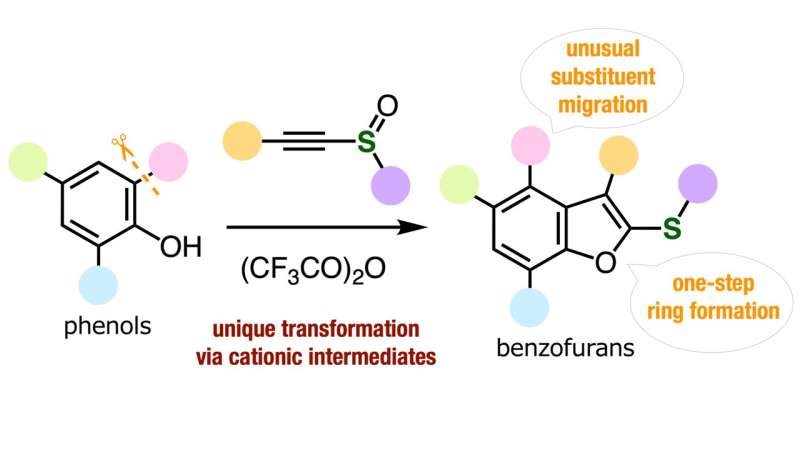This article has been reviewed according to Science X's editorial process and policies. Editors have highlighted the following attributes while ensuring the content's credibility:
fact-checked
peer-reviewed publication
trusted source
proofread
New benzofuran synthesis method enables complex molecule creation

In the field of organic chemistry, scientists are always looking out for new types of reactions to unlock synthesis routes for challenging compounds. Most of the progress that we have witnessed in pharmaceutics and agrochemicals over the past few decades can be traced back to the discovery of novel practical reaction pathways. Such pathways often involve the selective replacement of a functional group with another, the formation of aromatic rings, or the strategic cleaving of parts of a molecule. But what about the rearrangement of existing functional groups within a molecule?
Also known as "substituent migration," getting a functional group on an aromatic ring (such as in arenes) to jump to a different position in the ring is an attractive process. Chemists have come up with a few strategies to get functional groups to migrate, but the synthesis process gets significantly harder when dealing with arenes with a high number of functional groups. In particular, it is challenging to rearrange functional groups positioned next to the–OH group in phenols, a basic type of aromatic ring.
Fortunately, a research team led by Associate Professor Suguru Yoshida from Tokyo University of Science (TUS), Japan, has recently found an innovative solution to this problem. In their paper, which was published in Chemical Communications, the researchers present a new technique to synthesize various benzofurans through precise molecular rearrangement and substituent migration. Other members of the team included Dr. Akihiro Kobayashi and Mr. Shinya Tabata, both from TUS.
The researchers discovered, to their surprise, that an unusual substituent migration occurred when treating a simple aromatic compound known as o-cresol with alkynyl sulfoxide (AS) together with trifluoroacetic anhydride (TFAA). They found this reaction to partially yield a compound in which the functional group that would typically be next to the –OH group position (or "ortho" position) was instead at the neighboring position of the aromatic ring through benzofuran ring formation. This immediately prompted them to start peering into AS/TFAA-mediated reactions further.
The team eventually figured that when a substituted phenol reacts with AS and TFFA, TFAA first activates AS, which leads to the closing of a five-membered ring sharing one of its sides with the phenol. This type of resulting molecule is called a benzofuran.
Afterward, the imbalanced charges on the benzofuran trigger what's known as a "charge-accelerated sigmatropic rearrangement." Simply put, the formation of positively charged intermediate compounds enables the ortho functional group to migrate to the neighboring position on the phenol side.
The researchers demonstrated the versatility of their strategy by synthesizing a wide variety of benzofurans, some of which were highly functionalized or even fully functionalized. Notably, the yields of some of these compounds were exceptionally good, and in all cases, the composition of the functional groups was not damaged or altered by the process.
"Our modular synthesis method enabled us to produce diverse highly substituted benzofurans from easily available starting materials through substituent migration," highlights Dr. Yoshida. "Since various benzofurans have already been used as important bioactive compounds, newly accessible benzofurans could be of great importance in pharmaceutical sciences and agrochemistry."
Overall, this study has unlocked an innovative way of simply synthesizing complex benzofurans. The researchers hope their efforts will pave the way to better anti-cancer drugs, antibiotics, fungicides, herbicides, and more.
Worth mentioning, the potential applications of new highly functionalized benzofurans extend well beyond pharmaceutics and agrochemistry. They could also be used as tools in biological research, as dyes and pigments for textiles, as fragrances, and even as organic-electronic or fluorescent materials.
Now, all that is left is to perfect this promising synthesis technique and keep looking for more ways to control substituent migration. "Applications to the development of bioactive benzofurans, the synthesis of various heteroaromatics through similar reaction mechanisms, and theoretical studies with density functional theory calculations are ongoing in our laboratory," says Dr. Yoshida.
More information: Akihiro Kobayashi et al, Highly substituted benzo[b]furan synthesis through substituent migration, Chemical Communications (2024). DOI: 10.1039/D4CC01192A
Journal information: Chemical Communications
Provided by Tokyo University of Science




















